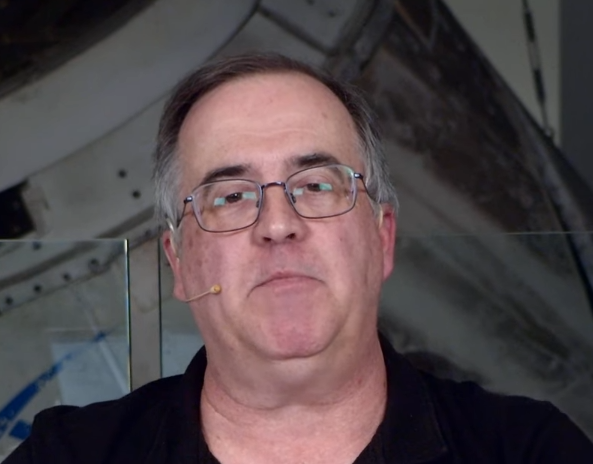

Please do, would be fun to follow along and discuss as events unfold.


Please do, would be fun to follow along and discuss as events unfold.


My prediction is that as pressures mount on all industries, especially food supplies, we’ll start to see large civil unrest leading ultimately to wars which will wipe most of us out first, then famine takes the rest. Agree on a few well off holdouts for a while.


Yeah, Tesla is certainly not the first ones to have this design or issues with it:
Any chance you are using a Thunderbolt device such as a network adapter or external drives? I had the issue on a NUC 10 where it would randomly drop the TB devices every few weeks and occasionally appear to be frozen. The latest firmware update finally took care of it.


Question is, how do you keep that from being abused?


Would you invision that to be similar to something like PBS but fully funded from government sources?


This is handled by the inverter and charging modules, some use FPGA chips others use dedicated ASICs, but it doesn’t require anything wild in terms of raw compute power, mostly up to having good algorithms to handle the situations correctly. Nothing more than a modern ICE engine which needs to very precisely manage intake and exhaust cam phasing, ignition timing, intake pressure, and multiple injections per cylinder/cycle along with monitoring a multitude of sensors to keep everything in tolerance. In terms of simplicity, the first automobiles at the turn of the century were electric before the ICE caught on thanks to the advent of the electric starter and limitations in battery technology at the time.


Not sure if the /s was left off or this was a serious question.
In the case it was a serious question, the first issue that comes to mind is when you seed clouds for one region, what happens to the next region downwind where the clouds would have rained without intervention? You are just moving the drought, there will still be a difference in the rain pattern somewhere.
Seeding to generate more cloud cover at a global scale introduces a whole host of problems. Firstly, you lower the solar output which then means solar power generation will be less effective. That energy will need to be produced by some means, which right now fossil fuels would be the most likely to take up the deficit, increasing atmospheric carbon output. Then to compound problems further, the reduced solar radiation reaching the surface would have a number of impacts such as plant growth being slowed reducing their CO2 uptake, less moisture being evaporated for precipitation over land masses, wind patterns being changed, and wind speeds reduced which means even further reduction in renewable energy generation. So with today’s technology seeding clouds would end up compounding the issues in the long term and accelerate the already alarming changes.
The headline is misleading. Roku didn’t get hacked and leak accounts. There were ~15000 customers that had accounts accessed due to credential stuffing. Aka, they reused passwords on other sites that had leaks and hackers tried those credentials on their Roku accounts and got into them.


Awesome, glad that helped and thanks for the update!


I wonder if there is something going on with scheduling waits that is impacting the audio process. I would first try upping the CPU units in Processors->Advanced settings for the VM, bump it to something like 200. Otherwise, if you over subscribing your CPU cores, try temporarily dropping the number of cores subbed out to your VMs to match the physical host to see if it helps, since that could help resolve scheduling issues as well.


Ah, good point, the speed changes for ICE results in lots of energy wasted as heat instead of being recaptured. That would certainly be the largest loss for an ICE in the city cycle.


Due to electric drivetrains having minimal fixed losses at low speed unlike internal combustion engines. Aerodynamic losses start becoming the largest factor for EVs at relatively low speeds (25-35 MPH) since other losses at so low. This shows up on tests as higher city efficiency and lower highway.
For an internal combustion engine you are burning a large amount of energy just to keep the engine running, so the slower the speed, the less distance traveled for the fixed amount of running losses and lower the MPG. It isn’t until higher speeds (55-65 MPH) that aerodynamic losses become the largest factor. This manifests as lower efficiency in the city tests and higher highway.


What was the EPA rated highway range? The 320 mile range is the EPA combined city/highway which you won’t hit doing entirely highway but you would beat doing entirely city.
Seems someone doesn’t understand how OAuth works. It does not automatically give full access to your social media accounts, location history, and device cameras as the video says.
Using the Google button for instance will tell you exactly what permissions are being requested every time you login. Generally, it will be name, email, language, and sometimes profile picture. Aside from the profile picture you would give all the same information anyway to create an account. At least with OAuth there is no worry about passwords, especially for people who don’t have good password practices and reuse passwords between different sites.


I did the Treatlife DS02S switch by flashing an ESP12F module with ESPHome following the guide here, then swapped the wireless module.
Works well as a normal independent switch with local control from Home Assistant.
I like the sentiment, but that is predicated on there being another election under the same rule set which would allow either party to win. If things come to pass with the unitary executive theory outlined in Project 2025 and the dictatorship desires that have already been declared, makes it unlikely votes will work to change political parties going forward…